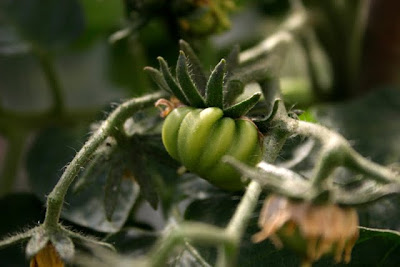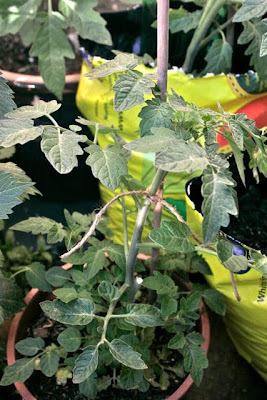 A little out of focus, but there it is - the first 'Jaune Flammée', and the third tomato harvested*. The skin was thick, and maybe it was a day or two too early (note the green tinges) - but it was delicious! Intense, sweet, fragrant, rich. The best reward, small though it is. Many more to come!
A little out of focus, but there it is - the first 'Jaune Flammée', and the third tomato harvested*. The skin was thick, and maybe it was a day or two too early (note the green tinges) - but it was delicious! Intense, sweet, fragrant, rich. The best reward, small though it is. Many more to come!
Another hungry gap! Usually, that phrase refers to the period at the beginning of the year, up to around April or May, when the overwintering veg (like cabbages and sprouting broccoli) is mostly harvested, and the spring stuff (peas, broad beans, potatoes, asparagus, salad leaves) isn't yet ready. Well, I've hit another one here in late July - but although it means my totals are well down right now, I can avoid it next year if I sow the right crops.
Simply put, the first flush of summer fruit and vegetables have been gathered and preserved or used. Meanwhile, the late summer harvest is still unripe. As I picked pretty much nothing in the first week, I decided to swap back to a fortnightly harvest update, but I'm hoping that I can revert to a weekly format soon. There were some things to be picked; spinach still provides - although I pulled up one plant that was being encroached by a lavender that's grown a lot since they were all planted in March, the remaining two are producing fairly tender flower spikes with small leaves that go nicely with pasta. The grape vines have grown rampantly for the most part (I need to control them at some point), which is excellent for stuffed vine leaves - something I made a lot of last year, but not as much as I wanted. The leaves are mostly a little smaller than I'd like, but it's not too hard to use two or three per roll. You can buy the leaves in specialist shops or some supermarkets, of course, but how much better to gather them from your own garden - so exotic for these climes. They are simply trimmed of their stalks, blanched in boiling water for a minute or so, and left to drain. Once you get the hang of wrapping them round rice (with various seasonings), or minced meat, or a combination of both, it's quite easy, and they have a lovely, distinctive, sharp taste from the tartaric acid they contain. Delicious.
The blackberries are early this year, like everything else. I left some to grow on an otherwise uncultivable patch of ground at the side of the back garden, but I will probably not leave them next year, as they always try to spread. I reclaimed much of the back from brambles over the past few years, but they are tenacious - they still sprout here and there (the trick is to dig them out, and keep attacking them whenever they appear). For now, though, the dark, soft, ripe fruit is very sweet, and ideal for a late batch of jam.
The highlight of this week, however, was the smallest harvest of all: the first tomatoes! The first of all was indoors, on the windowsill. The second was from a plant that had formed fruits similarly in response to stress, but that I'd planted up on the terrace, so it counted as the first outdoor tomato. Both were 'Gardener's Delight', a variety not known for being especially early, but which deals with adverse conditions better than most. The final one was 'Jaune Flammée', from the greenhouse plant that went in first. It has many fruits on several trusses, which are now taking on colour, but it's nearly five weeks late (based on the number of days this variety ought to take from final planting to harvest), so it's not perfect. Still, all were indescribably intensely flavoured and delicious, and the ultimate reward for all the work I've devoted to them so far. Just another 50-100kg would be nice now!
Totals for week 15th-31st July:
26th: 4g tomato
28th: 278g turnip tops, 35g shallot (day total: 313g)
30th: 3g tomato, 312g vine leaves**, 48g spinach, 478g blackberries*** (day total: 841g)
31st: 14g tomato, 72g spinach (day total: 86g)
Total for fortnight: 1.244kg
Total for July: 7.351kg
Year to date total: 18.942kg
Over a kilogramme isn't bad, I suppose, and I'm heading towards 20kg, which is another milestone. I just need more tomatoes to ripen! I'll continue to harvest vine leaves (another few in the coming week, probably, and then a second flush before they turn at the end of the summer) and blackberries - they ripen over a period of weeks. There are also saladings coming - a tray of mesclun (mixed leaves), and then the kailaan (which I've already potted on) and seedling thinnings. And more spinach I expect.
*In the last entry I asked of a tomato "how long before this is ready to pick?". This is the very same - so the answer is five days!
**I only include those from my garden; I will also harvest some from next door (my granddad's), but since I didn't grow them, they can't count towards the total.
***These grow unfettered on a strip between my garden and next door's fence. I didn't plant them, but allowed them to grow there, so I count them in my total.




























